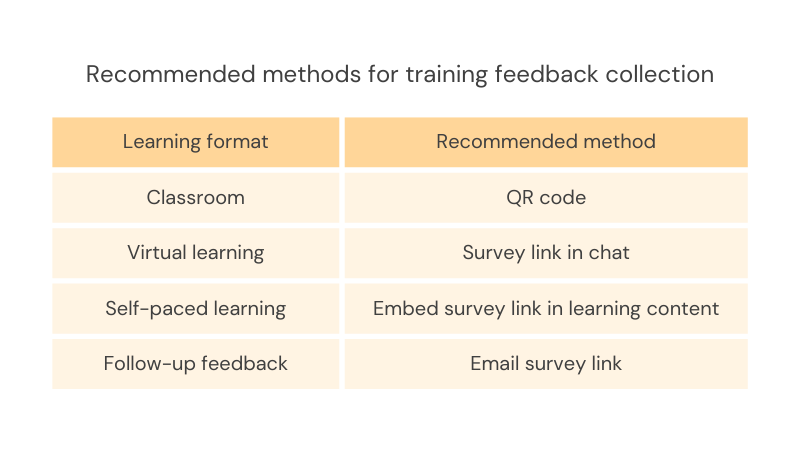
Training evaluation is key to informing improvements in course content, training delivery methods and overall course design. For training companies, feedback also has the power to drive business growth through independent reviews, and for Learning and Development teams, it demonstrates if their learning strategy is delivering on the overall business strategy.
Yet collecting meaningful feedback is something that training providers often struggle with. The reasons for this can vary, from low response rates on email surveys to a failure to properly involve and motivate instructors to effectively solicit feedback.
In this blog, we'll explore practical solutions to these challenges, examine the best methods for gathering insightful feedback, and share tips to help instructors drive high response rates and collect valuable data.
Best methods for feedback collection
While some training providers prefer the traditional method of paper feedback forms, online data collection is proven to bring many more benefits. Not only do learners prefer online surveys, but they’re easier to share, encourage honest feedback and provide faster and more meaningful data analysis.
Emailing online training feedback surveys after the course invariably generates a low response, but with the training feedback tools, digital surveys can be accessed on the spot. And there’s no reason why 100% response rate can’t be achieved.
The method for collecting feedback depends on the type of training, and the key is to choose a method that fits the specific training format:
- QR codes for classroom training
- Survey link in the chat box for virtual learning
- Embed survey links for self-paced training
- Email survey links for follow-up feedback

QR codes for classroom training
In a classroom environment, QR codes are by far the best way to collect feedback on the spot. Simply create a QR code that learners can scan with their devices in the classroom and set aside time for filling in the survey like you would a paper form.
Survey link in the chat box for virtual learning
For online learning, a training survey link can be pasted into the chat box of the online classroom. Follow the advice above by sharing the survey link towards the end — but not at the very end — of the course before learners start to log off.
Embed survey links for self-paced training
With self-paced training courses, the situation is different as there’s no instructor to guide your learners and encourage them to provide feedback. In this case, you rely solely on the design and delivery of your feedback forms to get responses. Embedding feedback questions throughout the content — along with some persuasive messaging — will make it an organic part of the learning experience and not something that can be easily skipped or missed.
Email survey links for follow-up feedback
To get better response rates on follow-up emails, you need to be strategic with both the subject line and the email body to trigger the learner to click on the survey link and offer their feedback. For the subject line, use phrases such as “Your recent training” or “The [course name] course you recently attended”. By making it clear the email relates to them they’ll be curious to open it, but don’t mention feedback in the subject line.
The body of the email should introduce the importance of providing follow-up feedback, and the key is to replicate what the instructor would do face-to-face, by sharing all the same sentiments but in the form of text. Use friendly, appreciative language to make them feel valued and more likely to provide thoughtful responses.

Getting your instructors on board
Course instructors are instrumental in driving response rates. The relationship learners build with their instructor can have a significant impact on how they feel about the course and how much they learn. And because of the rapport they’ve built, instructors are well placed to ask for, and receive, feedback.
Data analysis from half a million pieces of feedback collected using Coursecheck shows that even on the same course, different instructors can get very different response rates.
With such a huge variation, it’s no surprise that the way in which instructors approach feedback surveys and how they present them to their learners has a substantial impact not only on response rates, but also on the quality of the responses themselves.

How to get your instructors to drive quality feedback
Follow this guidance to ensure your instructors are not only getting a good number of responses but also good quality feedback.
- Give your instructors assurance that the whole process is for the good of the company. Be clear they know why you’re collecting feedback and what you want to achieve.
- Don’t assume it’s easy for your instructors to ask for feedback. Give them guidance on the best way to approach it, including a script. Even if they’re comfortable with the task, it’s important to have a consistent approach among all your instructors so that you get a consistent response.
- Incentivise instructors for their performance based on feedback metrics, such as a Net Promoter Score (NPS). By linking bonuses or rewards to high response rates and positive feedback, you demonstrate that you value their efforts and commitment. A league table based on response rates or NPS could be tied to rewards that instructors genuinely care about, such as financial bonuses or contributions to a charity of their choice. This approach not only shows that you are serious about feedback but also boosts employee engagement.
- Be transparent with the results. Make sure instructors are set up to receive reports so they can see what people have written about their training. Response rates will improve if they are engaged in the process and have visibility of the outcomes.
- Share the best practice tips on how to ask for feedback with your instructors, as outlined below, to ensure you are collecting large volumes of quality feedback.
5 best practice tips for instructors to ask for feedback
1. Give context
As with anything, context is important. Before you ask your learners for their feedback, explain why you’re collecting feedback and how you’re going to use it. If learners know you will be acting on their feedback, they are likely to be more thoughtful with their responses, knowing that it could make a difference to future iterations of the course.
2. Empathise
People are constantly inundated with requests for feedback from all aspects of their life. Make sure you empathise with your learners and assure them it will only take a few minutes of their time, and their feedback will be read and used to improve the training programme for future learners.
Put people at ease and tell them not to be shy; if there’s anything that could have been better, you want to know. Showing your appreciation for their feedback will go a long way in making participants feel valued and more willing to respond.
3. Approach it from an organisational perspective
For some, asking for feedback can be an uncomfortable task because you feel like you’re coming across as fishing for compliments. It’s easier to ask for feedback when introducing it from the organisation’s perspective, using words like “If there’s anything WE could have done better, please don’t hesitate to share”.
4. Introduce feedback early
Timing is key. Announcing at the very beginning of the training session the fact that you’ll be collecting feedback will mentally prepare learners for it. It will also make them more mindful throughout the course to consider what was useful and what could have been better.
5. Make it a focused activity
Share your training feedback surveys towards the end of the course, but not at the very end when participants are getting ready to leave. By making it a group activity as part of the course, learners are far more likely to respond and put thought into it.
How to ask for feedback: example questions that work
Here are some practical examples your instructor can use to ask for feedback in a way that gets honest, useful, and actionable answers.
At the end of a training session / course (spoken)
“Before we wrap up, I’d really value your thoughts on how this course went. What worked well for you, and what could we improve for next time?”
“Your feedback helps us make future sessions even better. What’s one thing you found most useful, and one thing you think we could do differently?”
“I’d love to hear your honest perspective — was the pace, content, and delivery right for you?”
Inviting written feedback (email)
“We’d really appreciate it if you could share your feedback — it only takes a few minutes, and it helps us improve the course for future learners.”
“Your opinion matters to us. Could you let us know what you enjoyed most, and what we could do to make the course even more useful?”
“We’re always looking to improve. What’s one suggestion you’d make for next time?”
Encouraging constructive criticism (so learners feel safe to be honest)
“Please don’t hold back — both positive and constructive feedback are welcome. The more specific you can be, the more helpful it is.”
“We want to know what really worked for you, but also what didn’t quite land, so we can keep improving.”
“There are no right or wrong answers — just your perspective. Even small comments can make a big difference.”
Follow-up (email after the course)
“Thank you for taking part in the course. We’re always trying to make our training as relevant and engaging as possible, so I’d love to hear: what was the most valuable takeaway for you, and what could we improve for next time?”
“I hope you found the course useful! Could you take a moment to share your thoughts? Your feedback helps us refine our content and delivery.”
You've collected the feedback; now transform your feedback into meaningful action.
Conclusion
In summary, gathering effective training feedback is vital for improving course quality and training delivery, driving business growth, and aligning learning strategies with broader business goals. By leveraging the influential role of instructors and adopting best practices in feedback collection, training providers can significantly improve response rates and the quality of insights gained.
By implementing these strategies, training providers can ensure they are continuously improving their offering based on valuable learner insights, ultimately leading to more effective training programmes and satisfied customers.
Turn your training feedback into real business results!